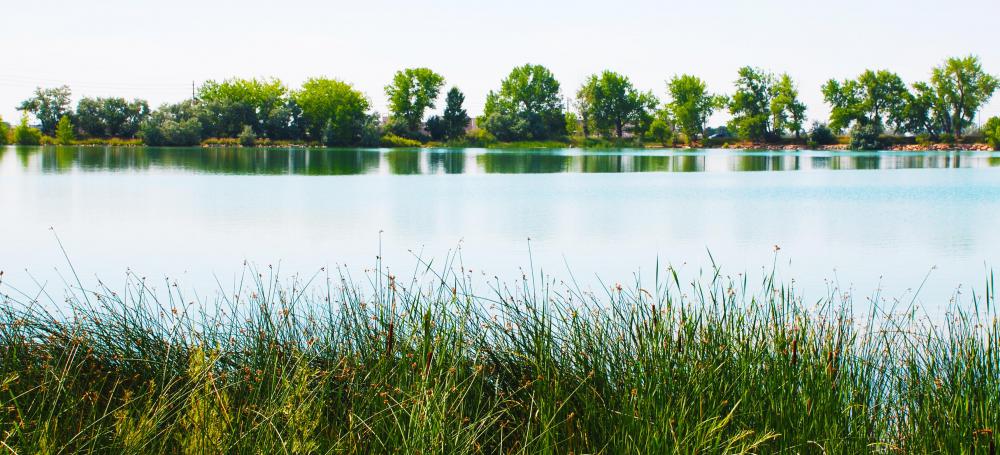At AllThingsNature, we're committed to delivering accurate, trustworthy information. Our expert-authored content is rigorously fact-checked and sourced from credible authorities. Discover how we uphold the highest standards in providing you with reliable knowledge.
What Is a Wetland Reserve Program?
A wetland reserve program represents a voluntary government program designed to protect and preserve wetlands on private agricultural property. Landowners may grant a lifetime easement to the land, or an easement that expires after a defined period of time. In return, the government pays for use of the land and its restoration. The goals of a wetland reserve program include developing recreational areas, providing habitat for fish and wildlife, preventing flooding, and recharging groundwater supplies.
Land being farmed or in its natural state might be eligible for the wetland reserve program, including pasture property. Areas that become flooded or where groundwater supplies are depleted might also be considered for a reserve. The program also accepts property adjacent to existing wetlands that might contribute to the preservation of natural resources in the region.

Property owners who participate in the wetland reserve program do not lose ownership of the land. They may lease it for hunting, fishing, bird watching, or other recreational activities. Landowners might also request other approved uses, such as cutting timber on the land or grazing livestock.
Payment to the landowner depends on the type of easement granted. For a permanent easement, the government pays either the value of the property in an agricultural zone, a capped amount, or the amount requested by the property owner. When a lifetime easement is granted, the government typically pays the full cost of restoration.

If a 30-year lease exists, payments for land and restoration total 75 percent, while 10-year leases only cover three-fourths of restoration expenses. Conservation groups commonly assist landowners with costs not covered by the government program. These groups typically work to regenerate wetland areas that have been lost. If permanent or 30-year easements are granted, the government picks up the full cost of recording and appraisal fees, surveys, and title insurance.
Benefits of the program include incentives to farmers unable to use their land because of flooding. Wetlands restoration also improves water quality by filtering silt and chemical deposits, and enhances the diversity of fish and wildlife. Some wetlands provide areas for scientific research, educational opportunities, and recreation.
The wetland reserve program was included in the U.S. Farm Security and Rural Investment Act of 2002. It is administered by the U.S. Natural Resources Conservation Service. Applications are available through the U.S. Department of Agriculture.
Frequently Asked Questions
What is the purpose of the Wetland Reserve Program (WRP)?
The Wetland Reserve Program is a voluntary initiative designed to restore and protect wetlands on private property. Its primary goal is to recover habitats for migratory birds, fish, and other wildlife, improve water quality by filtering sediments and chemicals, and reduce flooding by absorbing excess rainwater. The program offers financial and technical support to landowners for conservation efforts.
How does the Wetland Reserve Program benefit wildlife?
Wetlands are biodiversity hotspots, and the Wetland Reserve Program plays a crucial role in preserving this diversity. By restoring wetland ecosystems, the program creates a habitat for numerous species, including endangered ones. According to the USDA, restored wetlands provide breeding grounds, food, and shelter for wildlife, thereby supporting ecological balance and biodiversity.
Can landowners still use their property after enrolling in the WRP?
Yes, landowners can still use their property after enrolling in the WRP, but with certain restrictions to ensure the conservation objectives are met. The program typically allows for compatible uses like wildlife-friendly farming, hunting, and fishing, provided they do not harm the wetland's ecological functions. Landowners agree to maintain the wetland's integrity as part of the program's easement conditions.
What are the financial incentives for landowners to participate in the WRP?
Landowners who participate in the WRP receive financial incentives such as cost-share payments for restoring wetlands, and in some cases, compensation for enrolling their land in easements. The USDA's Natural Resources Conservation Service provides funding that may cover up to 100% of restoration costs and offers long-term easement payments to support the conservation of these vital ecosystems.
How does the WRP contribute to flood control?
Wetlands act as natural sponges, absorbing and storing excess rainfall, which can mitigate flooding. The WRP's restoration of wetlands enhances this capacity, providing a buffer in storm events. According to environmental studies, every acre of wetland can store approximately 1-1.5 million gallons of floodwater, significantly contributing to flood control efforts in surrounding areas.
Is the Wetland Reserve Program effective in improving water quality?
Yes, the Wetland Reserve Program is effective in improving water quality. Wetlands filter and clean water by trapping sediments, nutrients, and pollutants. The program's restoration efforts enhance these natural filtration processes. Studies have shown that wetlands can remove 20-60% of metals in the water and trap 80-90% of sediment from runoff, thereby improving water quality downstream.
AS FEATURED ON:
AS FEATURED ON:












Discuss this Article
Post your comments